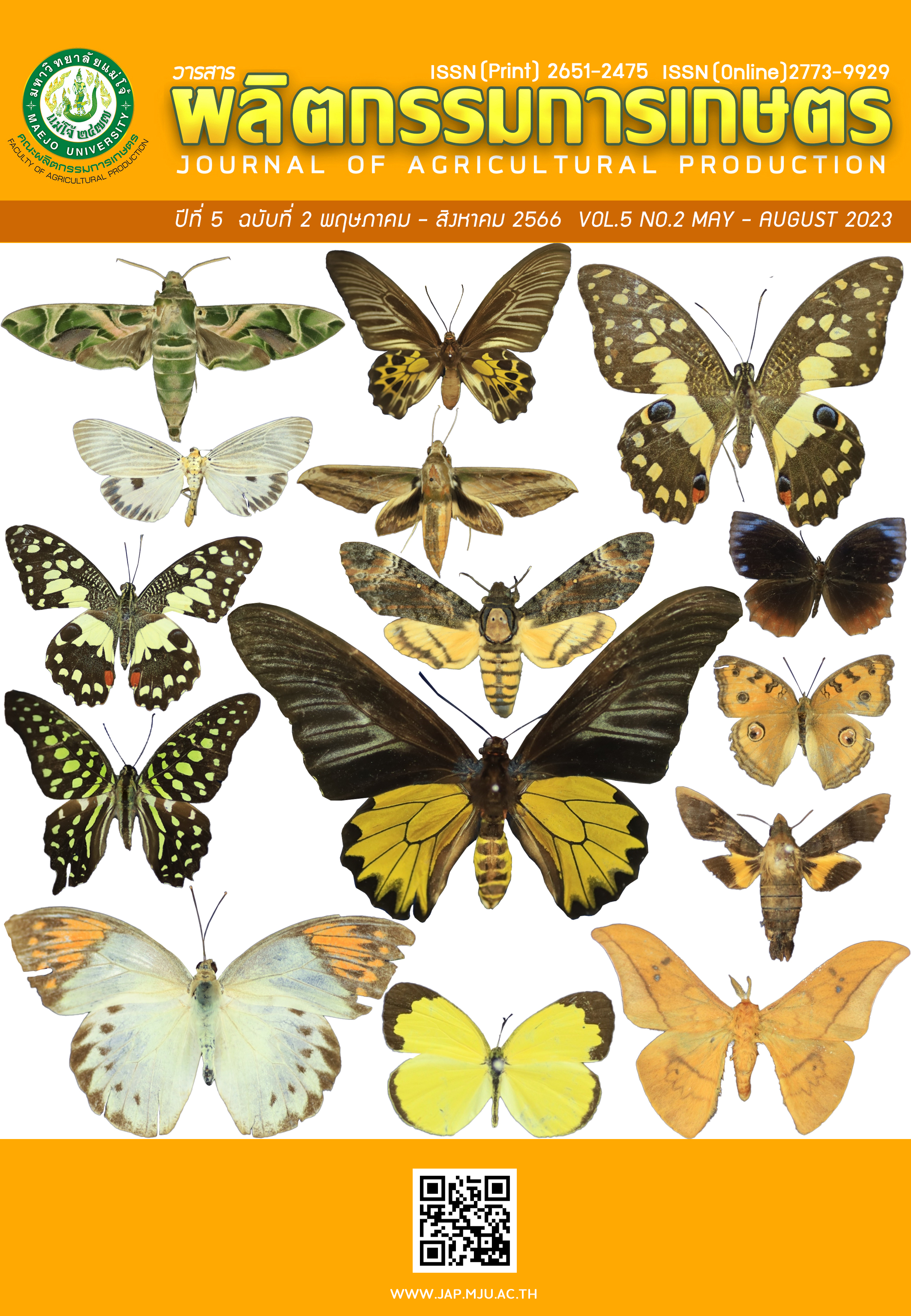ผลของอุณหภูมิ ต่อ ฤทธิ์ต้านอนุมูลอิสระในชาใบหม่อน และการผลิตชาใบหม่อนผง
Main Article Content
บทคัดย่อ
งานวิจัยนี้มีวัตถุประสงค์เพื่อ 1) ศึกษาผลของอุณหภูมิต่อฤทธิ์การต้านอนุมูลอิสระในการอบชาใบหม่อนที่อุณหภูมิ 3 ระดับ คือ 60 70 และ 80 องศาเซลเซียส เป็นเวลา 1 ชั่วโมง 2) ประเมินคุณภาพทางประสาทสัมผัสและความชอบโดยรวม 3) ศึกษาการผลิตชาใบหม่อนผง 4) ประเมินอายุการเก็บชาใบหม่อนและชาใบหม่อนผง ผลการทดลองพบว่า ชาใบหม่อนอบที่อุณหภูมิ 60 องศาเซลเซียส เมื่อวิเคราะห์ฤทธิ์การต้านอนุมูลอิสระโดยวิธีดีพีพีเอช มีประสิทธิภาพในการขจัดอนุมูลอิสระมากที่สุดคือ EC50 เท่ากับ 162.95±4.95 มิลลิกรัมต่อมิลลิลิตร ขณะที่ชาใบหม่อน อบที่อุณหภูมิ 70 และ 80 องศาเซลเซียส เท่ากับ 193.42±10.07 และ 256.17±7.68 มิลลิกรัมต่อมิลลิลิตร ตามลำดับ การยอมรับโดยรวมต่อชาใบหม่อนอบที่อุณหภูมิ 60 70 และ 80 องศาเซลเซียสอยู่ในระดับชอบเล็กน้อย เมื่อเก็บรักษาผลิตภัณฑ์ชาใบหม่อนอบที่อุณหภูมิ 60 องศาเซลเซียส เป็นเวลา 3 เดือน พบว่า ค่าความชื้นที่ระยะเวลาเก็บ 0 1 2 และ 3 เดือนเท่ากับร้อยละ 3.71±0.06, 4.17±0.04, 4.45±0.07 และ 4.55±0.36 ตามลำดับ และมีปริมาณเชื้อจุลินทรีย์ทั้งหมดเท่ากับ 3.8×103, 6.8×103, 7.8×103 และ 8.5×103 โคโลนีต่อกรัม ตามลำดับ โดยไม่พบ เชื้อแซลโมเนลลาและเชื้อสแตฟิโลค็อกคัส ออเรียส เมื่อเก็บรักษาผลิตภัณฑ์ชาใบหม่อนที่อุณหภูมิห้องเป็นเวลา 3 เดือน พบว่า ยังมีความปลอดภัยต่อการบริโภคตามมาตรฐานผลิตภัณฑ์ชุมชนเรื่องใบหม่อนแห้งชงดื่ม การผลิตชาใบหม่อนผงด้วยการทำแห้งแบบแช่เยือกแข็ง สำหรับการศึกษาครั้งนี้ สรุปได้ว่ามีความเป็นไปได้ที่จะพัฒนาสูตรชาใบหม่อนผงในการศึกษาครั้งต่อไป เนื่องจากเมื่อเก็บรักษาผลิตภัณฑ์ชาใบหม่อนผงเป็นระยะเวลา 3 เดือน พบว่า ค่าปริมาณน้ำอิสระไม่มีความแตกต่างกัน (p>0.05) มีค่าอยู่ในช่วง 0.22-0.30 และพบปริมาณเชื้อจุลินทรีย์ทั้งหมด เมื่อเก็บเป็นระยะเวลา 0, 1, 2 และ 3 เดือน เท่ากับ น้อยกว่า 10 น้อยกว่า 100 3.2×102 และ 3.8×102 โคโลนีต่อกรัม ตามลำดับ ซึ่งเป็นไปตามมาตรฐานผลิตภัณฑ์ชุมชนเรื่องสมุนไพรรวมผงสำเร็จรูป
Article Details

อนุญาตภายใต้เงื่อนไข Creative Commons Attribution-NonCommercial-NoDerivatives 4.0 International License.
เอกสารอ้างอิง
กรมหม่อนไหม. 2557. การผลิตชาใบหม่อนเชิงพาณิชย์. แหล่งข้อมูล https://qsds.go.th/wpcontent/uploads/2017/pdf/2014-11-04-tea.pdf (10 มกราคม 2564).
กิตติพัฒน์ โสภิตธรรมคุณ และปานทิพย์ รัตนศิลป์กัลชาญ. 2560. การสกัดและวิธีวัดความสามารถการต้านอนุมูลอิสระในพืชสมุนไพร. วารสารวิทยาศาสตร์และเทคโนโลยี หัวเฉียวเฉลิมพระเกียรติ 3(1): 86-94.
ธนกิจ ถาหมี พิไลรัก อินธิปัญญา และดุษฎี บุญธรรม. 2561. การประเมินอายุการเก็บรักษาผลิตภัณฑ์ชาชงใบหม่อนผสมผลหม่อนโดยวิธีสภาวะเร่ง. วารสารเกษตร 34(1): 157-166.
พัชรี สิริตระกูลศักดิ์ และสกุลกานต์ สิมลา. 2558. ผลของกรรมวิธีการประกอบอาหารต่อปริมาณสารต้านอนุมูลอิสระในดอกชมจันทร์. แก่นเกษตร 43(1):875-880.
ลือชัย บุตคุป อินทร์ตา ขานพรหม และศุภชัย สมัปปิโต. 2557. อิทธิพลของกระบวนการทำแห้งใบหม่อน (Morus alba L.) ในการผลิตชาเขียวต่อปริมาณฟลาโวนอยด์และฤทธิ์การต้านออกซิเดชัน. วารสารวิทยาศาสตร์และเทคโนโลยี มหาวิทยาลัยมหาสารคาม 27(1): 1-11.
วสันต์ นุ้ยภิรมย์ อัญชลี โพธิ์ดี และวิโรจน์ แก้วเรือง. 2556. หม่อนผลสดและการแปรรูป. กรมหม่อนไหม. กระทรวงเกษตรและสหกรณ์, กรุงเทพฯ.
วสันต์ สุมินทิลี่ ปนิดา บรรจงสินศิริ จันทนา ไพรบูรณ์ และ วรรณวิมล คล้ายประดิษฐ์. 2557. กิจกรรมการต้านอนุมูลอิสระของสารสกัดหยาบจากสาหร่ายพวงองุ่น (Caulerpa lintillifera) สาหร่ายทุ่น (Sargassum oligocystum) และสาหร่ายเขากวาง (Gracilaria changii). วารสารเทคโนโลยีการอาหาร 9(1): 63-75.
ศิริพร สอนสมบูรณ์สุข. 2561. การพัฒนาผลิตภัณฑ์มะตูมผงสำเร็จรูปด้วยการทำแห้งแบบพ่นฝอย. วิทยานิพนธ์วิศวกรรมศาสตรมหาบัณฑิต สาขาวิชาวิศวกรรมเครื่องกลและระบบกระบวนการ คณะวิศวกรรมศาสตร์, มหาวิทยาลัยเทคโนโลยีสุรนารี.
เศรษฐการ นุชนิยม. 2554. การผลิตน้ำตำลึงผงโดยการทำแห้งแบบเยือกแข็ง. วารสารวิทยาศาสตร์และเทคโนโลยี 19(2): 51-63.
สำนักงานมาตรฐานผลิตภัณฑ์อุตสาหกรรม. 2556. สมุนไพรรวมผงสำเร็จรูป. แหล่งข้อมูล https://tcps.tisi.go.th/pub/tcps1441_56(สมุนไพรรวมผงสำเร็จรูป).pdf (16 มกราคม 2564).
สำนักงานมาตรฐานผลิตภัณฑ์อุตสาหกรรม. 2558. ใบหม่อนแห้งชงดื่ม. แหล่งข้อมูล https://tcps.tisi.go.th/pub/tcps0030_58(ใบหม่อนชงดื่ม).pdf (16 มกราคม 2564).
สิริการ หนูสิงห์ ปาจารีย์ มันดี และบุศราภา ลีละวัฒน์. 2557. การพัฒนาชาข้าวก่ำเพาะงอกพร้อมชง. วารสารวิทยาศาสตร์และเทคโนโลยี 22(3): 337-346.
สุรชัย อุตมอ่าง นิรมล อุตมอ่าง และรัฐนันท์ พงศ์วิริทธิ์ธร. 2558. การยอมรับและพฤติกรรมของผู้บริโภคต่อผลิตภัณฑ์ชาสมุนไพรไทย. วารสารศรีนครินทรวิโรฒวิจัยและพัฒนา (สาขามนุษยศาสตร์และสังคมศาสตร์) 7(13): 187-199.
อุไรภรณ์ บูรณสุขสกุล อลงกต สิงโต นริศา เรืองศรี และ ปิยะพงษ์ ประเสริฐศร. 2562. ผลของการดื่มชาใบหม่อนต่อระดับน้ำตาลในเลือดและระดับความอิ่มในอาสาสมัครสุขภาพดี. วารสารศรีนครินทร์เวชสาร 34(3): 237-242.
Afzal, F., W. Khalid, M.N. Asif, A. Jabeen, R.P. Jha, M.Z. Khalid, C. Fizza, A. Aziz, R. Akram, A. Bashir, S. Younas, F. Nayyer, R. Yasin and M.Z. Ahmad. 2021. Role of mulberry leaves in human nutrition: a review. J. Acta Scientific Nutritional Health 5(3): 43-50.
AOAC. 2000. Official methods of analysis of AOAC International. 15th Edition. Arlington: AOAC International.
Sarkhel, S. and D. Manvi. 2021. Processing of mulberry leaves: a review. J. Int. J. of Chemical Studies 9(1): 859-865.
Shah, P. and H.A. Modi. 2015. Comparative study of DPPH, ABTS and FRAP assays for determination of antioxidant activity. J. IJRASET 3(4): 636-641.
Taufik, Y., T. Widiantara and Y. Garnida. 2016. The effect drying temperature on the antioxidant activity of black mulberry leaf tea (Morus nigra). J. RASAYAN J. Chem. 9(4): 889-895.
Thaipitakwonga, T., S. Numhomb and P. Aramwita. 2018. Mulberry leaves and their potential effects against cardiometabolic risks: a review of chemical compositions, biological properties and clinical efficacy. J. Pharmaceutical biology 56 (1): 109-118.


